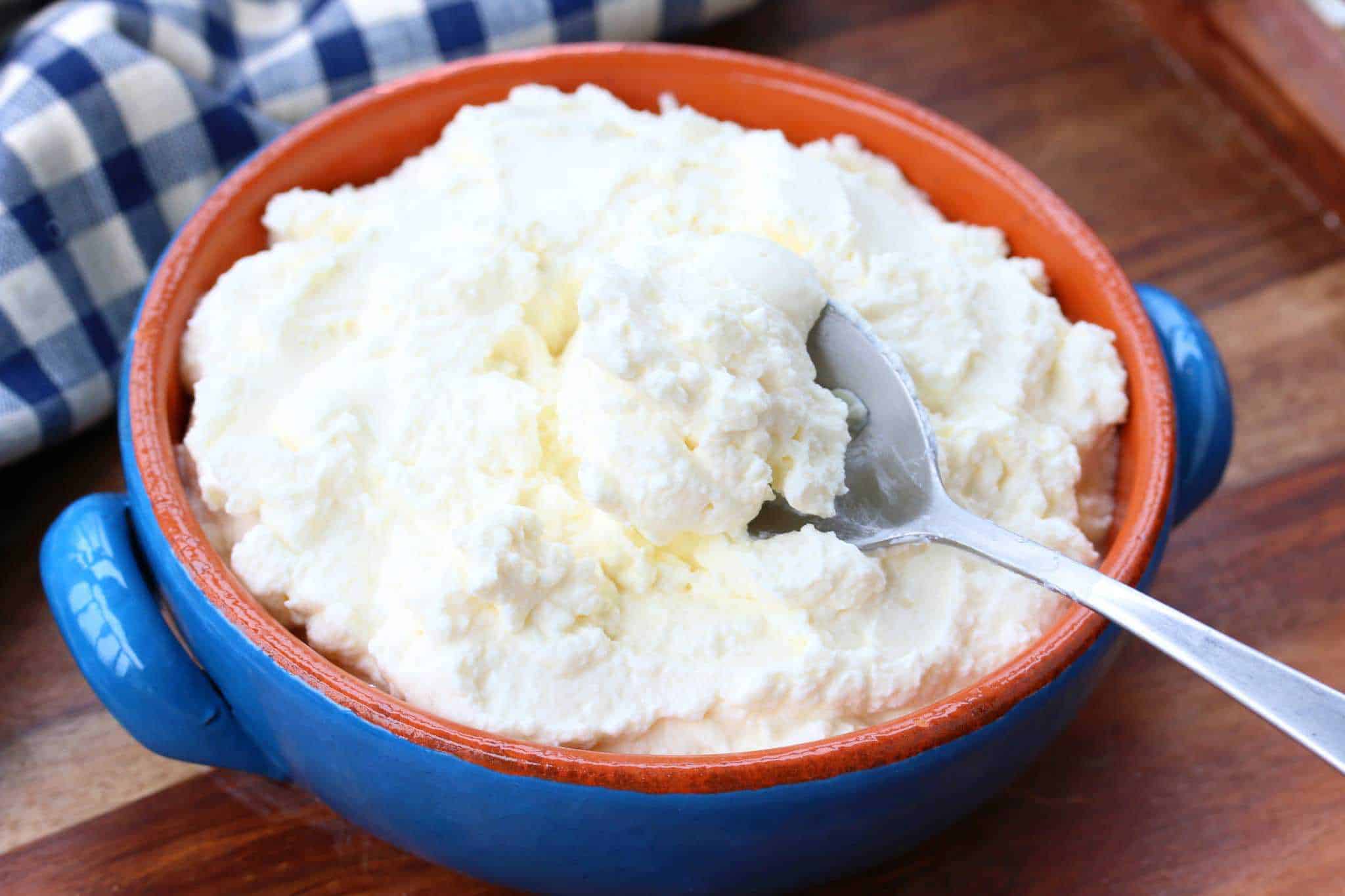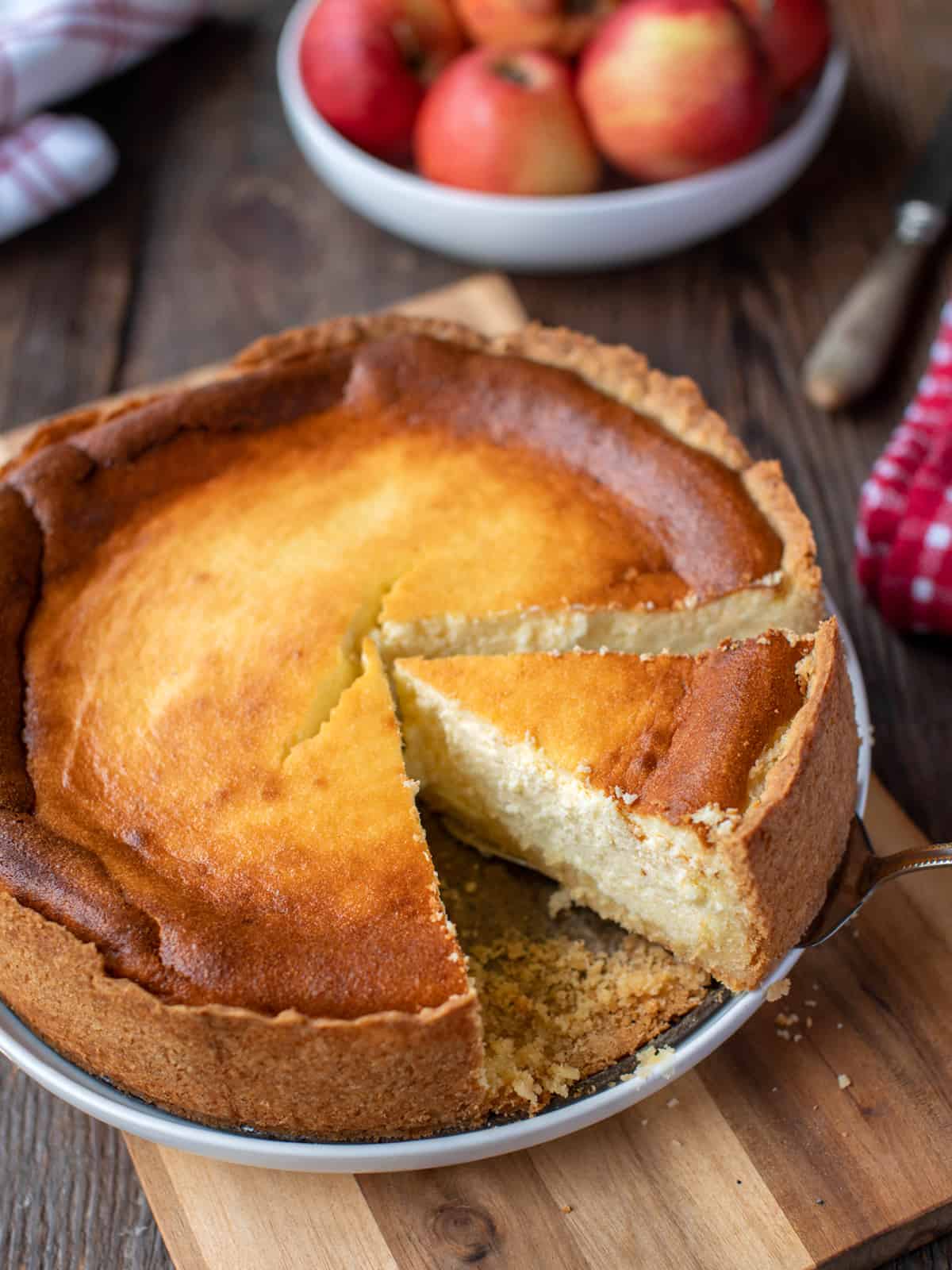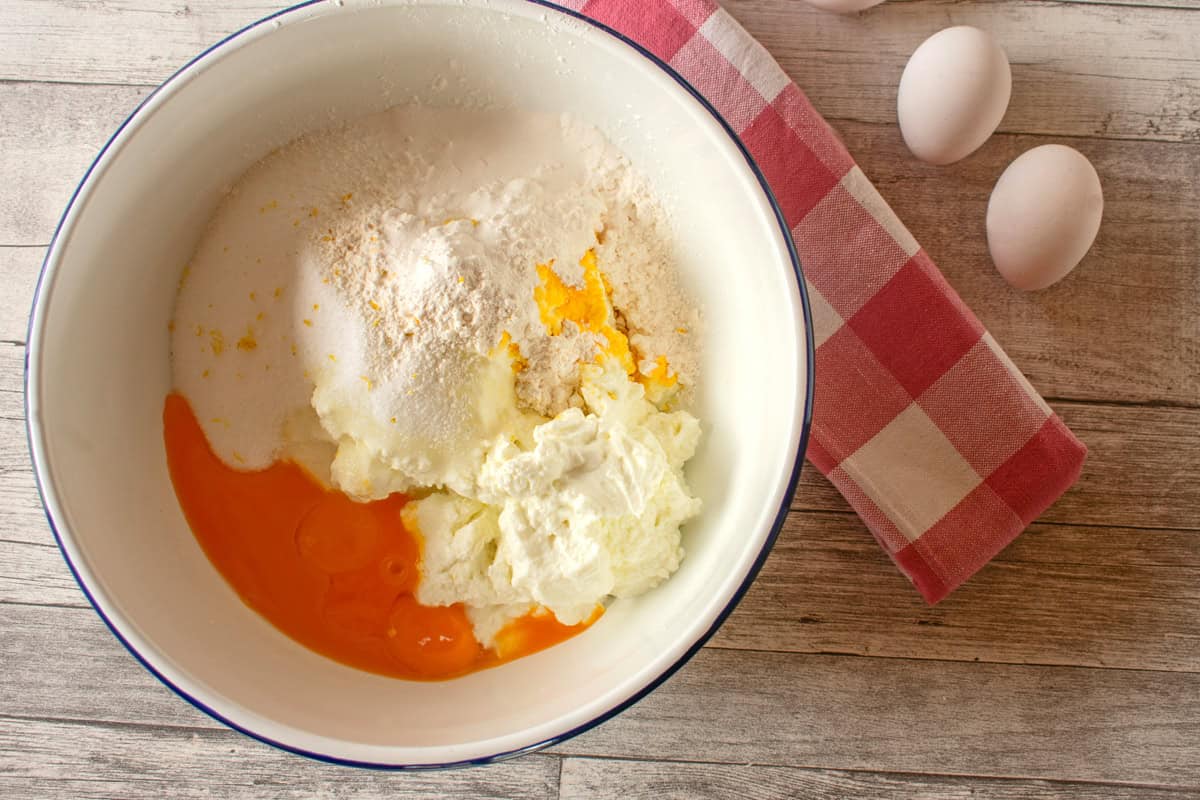German Cheesecake (Käsekuchen)
This post may contain affiliate links. See my disclosure policy.
Light and airy, sweet and tangy – that’s authentic German cheesecake! This Käsekuchen is how my Mutti and Oma made it and it is delicious on its own or can have fruit added to it. Made fully from scratch without vanilla pudding mix, it tastes like it came from a professional German Konditorei!

If you’ve been to Germany and have had Käsekuchen, you know that it’s something special. This German cheesecake recipe is easy to make, is made entirely from scratch (no vanilla pudding powder!), will take you down memory lane and transport you to cheesecake heaven!
German Cheesecake vs American Cheesecake
While American cheesecake is made with cream cheese and is quite dense in texture, German cheesecake is made with Quark, which is tangier in flavor and has a lighter, airier texture. American cheesecake is made with a graham cracker crust while German cheesecake is made with a shortcrust pastry called Mürbeteig. Another notable difference is that German cheesecake is far less sweet. It is usually eaten without toppings or sauces but there are popular variations that incorporate fruit in the filling, like mandarin oranges, apples, pears or berries. My Mutti often made a Blechkuchen (sheet pan) version topped with mandarin orange segments that was a family favorite.

What is Quark?
Quark is a kind of soft cow’s cheese that is made from strained soured milk and is high in protein and generally low in fat. It’s not a yogurt, it’s not cottage cheese, and it’s not ricotta. Flavor and texture-wise, it can be described as something of a combination of them. It has been made for millennia in different countries by different names, but is most notably called Quark and is strongly associated with German cuisine. It’s a versatile cheese and is used in both sweet and savory recipes.
What Can I Substitute for Quark?
In Germany, Quark is inexpensive and can be found in any grocery store, but it’s much harder (and more expensive) to source elsewhere. If you can find it, use it, because it really is unique and no substitutions can quite capture the flavor and texture. If you cannot find it you have a few options:
- Make it yourself! I’ve got you covered with a detailed, step-by-step tutorial on How to Make Quark.
- Quark is something of a cross between yogurt, cottage cheese and ricotta, and while obviously not exactly the same, you can substitute one of those. If using yogurt, use Greek yogurt and strain it in a cheesecloth to thicken it (you’ll want 500 grams of strained, thickened yogurt). If using cottage cheese, first blend it until it’s smooth.

Pro Tips for Making German Cheesecake
The most common challenges are the top of the cake cracking too much (a small crack is perfectly normal) and the cake not being fully set. To avoid these problems do the following:
- After the cheesecake is finished baking, turn the oven off and leave the cake inside the oven with the door cracked open. The sudden change in temperature from going to a hot oven to room temperature will often cause the filling to crack. Allowing the cake to cool in the oven reduces this risk.
- Let the cheesecake to fully cool before removing it from the springform and slicing it. I know it’s hard to be patient, but that will ensure the cake is set and you’ll get those nice, clean slices.

German Cheesecake Recipe
Let’s get started!
Preheat the oven to 350 F / 180 C and place the rack on the bottom third of the oven.
To make the pastry crust: Place the butter, sugar and vanilla sugar in the bowl of a stand mixer fitted with the paddle attachment and mix until creamy. Add the egg and mix to combine. Add the flour, baking powder and salt and mix until it comes together in a dough. Alternatively, place everything in a food processor and pulse until the ingredients come together, then turn out onto the counter and knead to form a dough. Or place all the ingredients in a large mixing bowl and knead the mixture together with your hands until a dough forms.
Butter a 10 inch / 26cm springform. Press the dough onto the bottom and about an inch up the sides of the springform. It may initially appear like there isn’t enough dough, but keep pressing it to form a thin, even layer throughout, making sure there are no cracks that could cause leakage. Chill in the fridge while you prepare the filling.

To make the filling: Place the butter, sugar, vanilla sugar or extract, eggs, cornstarch and salt in a large mixing bowl and beat until smooth. Add the quark, sour cream, lemon zest and juice and beat until smooth.

In a clean mixing bowl, beat the heavy whipping cream until stiff. Fold the whipped cream into the filling mixture until thoroughly combined.

Pour the filling into the crust and smooth over the surface. Bake for about an hour until the cheesecake has puffed up and is nicely browned on the top. The cheesecake should be quite firm to the touch but with a slight jiggle in the middle.

Turn the oven off and leave the cheesecake inside with the oven door partially open (this will help prevent the top of the cake from splitting due to a sudden temperature change). Allow the cheesecake to fully cool before removing it from the springform and slicing, otherwise you run the risk of the cheesecake not being fully set. The puffed up top of the cheesecake will sink in the center as it cools and be slightly concave.

Store your Käsekuchen in the fridge where it will keep for 3-4 days.
Before serving, let the German cheesecake come to room temperature. This improves both the flavor and the texture.
Enjoy!

For more delicious traditional German cakes be sure to try my:
- German Apple Cake
- German Plum Cake
- German Rhubarb Streusel Cake
- Apple Strudel (not technically a cake, but it’s a must!)
Save This Recipe

German Cheesecake (Käsekuchen)
Equipment
Ingredients
- For the Crust:
- 6 tablespoons unsalted butter , softened
- 1/3 cup sugar
- 1 packet vanilla sugar
- 1 egg
- 1 1/2 cups + 2 tablespoons all-purpose flour
- 3/4 teaspoon baking powder
- 1/4 teaspoon salt
- For the Filling:
- 8 tablespoons unsalted butter , softened
- 3/4 cup sugar
- 2 packets vanilla sugar (or 2 teaspoons pure vanilla extract plus two tablespoons sugar)
- 3 eggs
- 1/4 cup cornstarch
- 1/4 teaspoon salt
- 500 grams Quark *see note below (click link for homemade Quark recipe!)
- 3/4 cup full fat sour cream
- zest and juice of one lemon
- 3/4 cup heavy whipping cream
Instructions
- Preheat the oven to 350 F / 180 C. Place the rack on the bottom third of the oven.To make the pastry crust: Place the butter, sugar and vanilla sugar in the bowl of a stand mixer fitted with the paddle attachment and mix until creamy. Add the egg and mix to combine. Add the flour, baking powder and salt and mix until it comes together in a dough. Alternatively, place everything in a food processor and pulse until the ingredients come together, then turn out onto the counter and knead to form a dough. Or place all the ingredients in a large mixing bowl and knead the mixture together with your hands until a dough forms. Butter a 10 inch / 26cm springform. Press the dough onto the bottom and about an inch up the sides of the springform. It may initially appear like there isn't enough dough, but keep pressing it to form a thin, even layer throughout, making sure there are no cracks that could cause leakage. Chill in the fridge while you prepare the filling.
- To make the filling:Place the butter, sugar, vanilla sugar or extract, eggs, cornstarch and salt in a large mixing bowl and beat until smooth. Add the quark, sour cream, lemon zest and juice and beat until smooth. In a clean mixing bowl, beat the heavy whipping cream until stiff. Fold the whipped cream into the filling mixture until thoroughly combined.
- Pour the filling into the crust and smooth over the surface. Bake for about an hour until the cheesecake has puffed up and is nicely browned on the top. The cheesecake should be quite firm to the touch but with a slight jiggle in the middle. Turn the oven off and leave the cheesecake inside with the oven door partially open (this will help prevent the top of the cake from splitting due to a sudden temperature change). Allow the cheesecake to fully cool before removing it from the springform and slicing, otherwise you run the risk of the cheesecake not being fully set. Store your Käsekuchen in the fridge where it will keep for 3-4 days. For the best texture and flavor, let it come to room temperature before eating.



















Oh this was perfection!! I made this for my German in-laws who were here visiting and they said they’ve never had a better kaesekuchen and my MIL even asked for the recipe!
That’s wonderful, Lynne, I’m so thrilled to hear that, thank you! <3
are you able to add fruit ( peaches )?
Hi Larry, yes you can!
German family approved! Impressed my boyfriend, adding this to my personal home recipies <3
Wonderful! I’m so glad it was hit, thank you kiyo!
Cheesecake and recipe look wonderful!…Grew up in Germany but have been in the NW of the US since age 19 (now 84)…I can’t get Quark and do not want to make it. But I have used various combinations of cream cheese, greek yoghurt, sour cream, creme fraiche, ricotta etc. to make cheesecakes. What are your thoughts on using any of those and Cream Cheese instead of Quark for this recipe?
Hi Gudrun, yes it definitely takes some time and effort to make homemade Quark. It’s slowly been becoming a little more available though and I’ve heard that some stores like Whole Foods carries it now (though with a hefty price tag I’m sure). I include a discussion in my blog post about some of the substitutions you mentioned. Quark is something of a cross between yogurt, cottage cheese and ricotta, and while obviously not the same, you can substitute any one of these. Those are better options than sour cream or creme fraiche for tasting a little more like real German cheesecake. If using yogurt, I recommend using Greek yogurt and straining it in a cheesecloth to thicken it (you’ll need 500 grams of strained, thickened yogurt). And if using cottage cheese you would first blend it until it’s smooth.
This was phenomenal! I have very high standards when it comes to German cheesecake because it was my favorite thing to buy at my local bakeries when I lived in Germany. I have made several of your other German recipes (which are all excellent) so I felt pretty confident that this was going to be good. I was wrong. It was better than good – it was AMAZING! This is an absolutely stellar, authentic German cheesecake and one that I will make again and again. Thank you, Kimberly!
Fantastic, thank you so much, Sue, I’m thrilled that you enjoyed it and appreciate the compliment and the feedback! <3
I’ve made this twice now substituting strained Greek yogurt the first time and pureed cottage cheese the second time. It’s delicious both ways but I think I prefer the strained Greek yogurt. Wonderful recipe, it’s just like the kaesekuchen I regularly had when I lived in Germany 2003-2008. Thank you!
Wonderful! I’m so glad you enjoyed it, Connie, thank you very much for the feedback! <3
Thank you for the best German baked cheesecake. Here in South Africa I’ve substituted 50/50 – plain smooth cottage cheese/creamed cottage cheese for Quark.
Fantastic, Mel, I’m so glad you enjoyed it, thank you! <3
Hello Kimberly, I would like to try this German cheesecake recipe for Christmas. If I bake it now, can I store it in the freezer until Christmas time?
Thank you for your recipes I have made quite a few of them and get many compliments from my German family.
This was super lecker, wonderful creamy texture and delicate flavor.
Thank you, Simone, I’m so glad you enjoyed it!
This was exquisite! So creamy and so delicious, a genuine taste of home <3 Thank you so much for sharing your recipe, Kimberly.
Thank you so much, Marianne, I’m thrilled that you enjoyed it and appreciate the feedback! <3
Thank you for this recipe! I just came back from a trip to Germany, visiting family, and promised myself I would make German cheesecake once back home. Of course I got busy and forgot about it –
Now that I just found your recipe in my inbox, I have no more excuses, other than that I’m missing two ingredients, but that can be remedied with a trip to the grocery store! By the way, I found that Norwegian Skyr is the one dairy product we can get here that tastes almost exactly like quark, which I sorely miss. I have never baked with it, though, partially because it is crazy expensive, but I’m thinking of using it for a one-portion-size-cheesecake, just as an experiment.
Hi Gabriele, fantastic, I’m excited for you to try it! :) Quark is quite a bit less acidic than Skyr, which is more akin to yogurt and more tangy in flavor. If I recall, it’s also not as thick as Quark? I’ve heard that you can get Quark at Trader Joe’s and Whole Foods, at least at some locations. I’m sure it isn’t cheap either but I doubt it’s any more than Skyr.
Kimberly, we used to be able to get quark here in Ontario. It is very difficult to find now. There is one European deli where I live that sells what they call quark but it’s very dry and does not yield the best results. Are there any good substitutes?
Hi Sue, I’ve heard but have not verified that Whole Foods sells Quark. Flavor-wise and texture-wise Quark is something of a cross between yogurt, cottage cheese and ricotta, and while obviously not exactly the same, you could substitute one of those. If using yogurt, use Greek yogurt and strain it in a cheesecloth to thicken it (you’ll want 500 grams of strained, thickened yogurt). If using cottage cheese, first blend it until it’s smooth.
Just make your own quark. It’s not difficult and a lot more affordable! Look up how to make quark geese in Kimberly’s page. One gallon milk makes about 1750 gr. You can freeze the quark for other uses but I wouldn’t make the quark Kuchen with it.
We’re lucky to have quark at our local co-op and this cheesecake came together beautifully. Such a creamy texture and not overly sweet, it’s perfect. I definitely recommend this recommend to anyone thinking about trying it.
That’s wonderful, Miriam, thank you so much for the feedback, I’m thrilled that you enjoyed it!
Liebe Kimberly, I made this and my verdict: Lecker! Not that that came as any surprise. The Käsekuchen was so creamy, so flavorful, and I guiltily admit that I had three slices in one day! To save myself from myself I brought some of the cake over to a dear friend and she described it as one of the most delicious cheesecakes she has ever tasted. Danke, danke, Kimberly, for another marvelous recipe!
Wunderbar! <3 I'm so thrilled that you enjoyed it, Katrin, and appreciate the feedback! I'm so happy that your friend likewise enjoyed it :) Thank you!
Oh liebe Kimberly, I’ve been waiting for this one! I have made so many of your recipes over the years and love them all, especially the German ones. It’s been years since I’ve had a proper German cheesecake and I already know this one is going to be amazing. I love the sound of the sour cream added to the filling mixture. And I especially love that this is made from scratch – so many recipes use storebought vanilla pudding! I will be making this kaesekuchen this weekend and will let you know how it goes, though I already know how it’s going to go! :) Hugs, Katrin
Vielen Dank, Katrin <3 I appreciate those kind words and the vote of confidence. Happy baking and I hope you enjoy it! <3